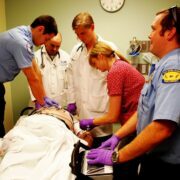Noticing blood in stools can be frightening and distressing for most people. Not knowing where it originates and the idea of a possible serious underlying condition like cancer can magnify the fear. It becomes alarming when the blood present is a large quantity and the patient has no rational explanation.
In some instances, blood originating from the patient’s upper intestinal tract like the stomach and oesophagus as well as the anus and colon. Bleeding occurring in the patient’s upper digestive tract can make stools appear tarry and black. If the blood in stools originated from the patient’s lower gastrointestinal tract, it can appear bright red.
Table of Contents
Blood in the Stools: Potential Causes
There are several possible causes for this. Possible causes include:
- Esophageal problems like dilated veins in the oesophagus (can be associated with chronic liver disease)
- Ulcers found in the patient’s upper gastrointestinal tract (this can be a sore or open ulcer in the lining of the duodenum, stomach, or the intestine’s upper end.
- Piles or haemorrhoids
- Anal fissure (a tear in the anal lining)
- Cancer or polyps
- Inflammation or colitis caused by infection or inflammatory bowel diseases such as ulcerative colitis or Crohn’s disease
- Angiodysplasia (fragile and abnormal blood vessels in the intestines)
- Other conditions like blood vessel or disorders in blood clotting
Passage of blood in the rectum is not rare and can often be caused by piles or haemorrhoids. However, it’s a matter that should be taken lightly especially in countries like Singapore since colorectal was prevalent among men.
Many patients with colorectal cancer have blood in their stools as one of the primary symptoms of the condition. During the initial assessment, the age of the patient as well as the bleeding amount and type are important considerations. Rectal bleeding will also be evaluated.
Related Symptoms
For patients with bleeding PR (per rectum), initial workup can include physical examination and the history of the patient. Other important symptoms and history that will be considered include:
- Weight loss
- Anal symptoms (persistent pain or mass)
- Bleeding nature and quantity (bright and fresh red blood can typically originate from the patient’s lower gastrointestinal tract. Blood loss may not be visible to the naked eye (occult blood)
- Tenesmus (this refers to incomplete emptying. This can also be a possible symptom of rectum cancer. Tenesmus can be caused by a tumour that is found in the rectum that causes the sensation)
- History of polyposis or colorectal cancer in the family (i.e., hereditary nonpolyposis colon cancer
- Trauma, medical history, prior radiation treatment, and the use of aspirin or other medications
General examination can also include rectal and perianal examinations. A proctoscope is used to determine the cause of the hemorrhoid bleeding.
Additional Evaluation
When checking for anaemia (this can mean bleeding from a cancer in the bowels), full blood counts will be done. If doctors suspect the patient has colorectal cancer, colonoscopy is done to confirm the suspicion (though a biopsy).
When detected early, colorectal cancer can be treated successfully. In case there is severe bleeding, fluids, resuscitation, and transfusion is done before definitive interventional/surgical procedures will be done.














Comments